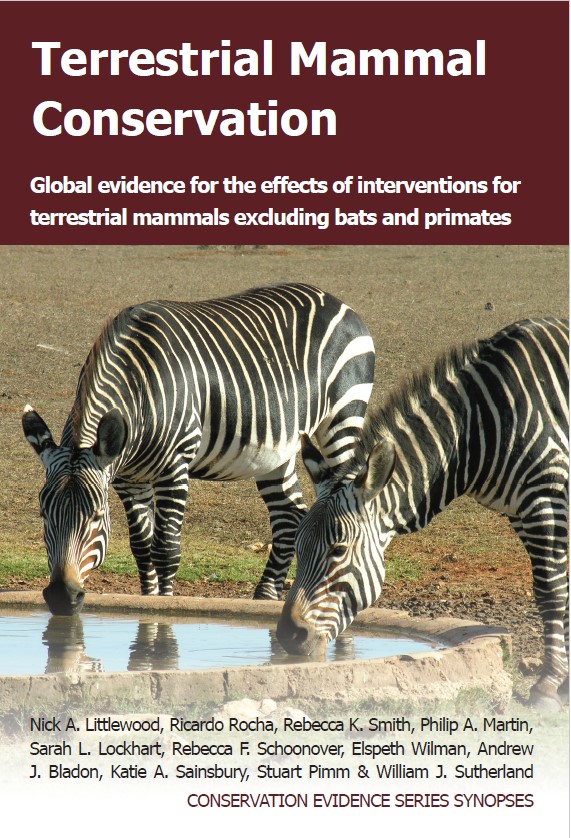Clear or open patches in forests
-
Overall effectiveness category Unknown effectiveness (limited evidence)
-
Number of studies: 4
View assessment score
Hide assessment score
How is the evidence assessed?
-
Effectiveness
32% -
Certainty
30% -
Harms
0%
Study locations
Supporting evidence from individual studies
A replicated, site comparison study in 1998 of tropical forest in Bolivia (Fredericksen et al. 1999) found that creating forests gaps, by selective felling, did not increase small mammal abundance relative to that in undisturbed forest. The number of small mammals trapped did not differ between large gaps (7.0/plot), small gaps (6.8/plot) and undisturbed forest (5.2/plot). Similarly, total species richness did not differ between large gaps (four species), small gaps (five species) and undisturbed forest (five species). Trees were harvested selectively, creating gaps, in June-October 1997. Within each of six blocks, one small gap (average 247 m2), one large gap (average 811 m2) and one undisturbed area (400 m2) were studied. Treatments in a block were separated by <100 m. Small mammals were monitored using eight Sherman live traps and a larger cage trap, set in each gap or undisturbed forest area, for six days each in April, July, and November 1998.
Study and other actions testedA replicated, controlled study in 1995–1997 of three stands in a coniferous forest in Washington, USA (Gitzen & West 2002) found that creating gaps in forests did not increase abundances of most small mammal species. Species responses to treatments were not tested for statistical significance. Five to six years after gap creation, there were no clear treatment preferences among the most frequently recorded species, Trowbridge’s shrew Sorex trowbridgii (large gaps: 0.5–3.5/100 trap nights; forest: 0.0–3.8), Keen’s mouse Peromyscus keeni (large gaps: 3.1–5.4/100 trap nights; forest: 1.9–5.9) and southern red-backed vole Clethrionomys gapperi (large gaps: 0.5–1.9/100 trap nights; forest: 0.4–1.9). Seven years after gap creation, there was a similar lack of clear treatment preferences among the shrew species, montane shrew Sorex monticolus (medium gaps: 0.0–4.2/100 trap nights; large gaps: 0.3–0.6; forest: 0.6–1.2), Trowbridge’s shrew (medium gaps: 1.8–7.7/100 trap nights; large gaps: 1.2–5.7; forest: 2.1–4.8) and vagrant shrew Sorex vagrans (medium gaps: 0.0/100 trap nights; large gaps: 0.0–0.6; forest: 0.0–0.3). Gaps were created in 1990 in three Douglas-fir Pseudotsuga menziesii dominated stands, c.90, 140 and 500 years old. Gap diameters were 1 (large) and 0.6 and 0.4 (medium) times the average surrounding tree height. There were two replicates of each size/stand. Differing combinations of treatments and stands was sampled for small mammals in summer and autumn 1995–1997 using live traps, killing traps and pitfall traps.
Study and other actions testedA replicated, controlled, before-and-after study in 1994–1998 of a coniferous forest in British Colombia, Canada (Klenner & Sullivan 2003) found a greater abundance of one small mammal species when forest was harvested in small patches, relative to clearcutting, but not of three other species. Populations of all species did not differ between treatment plots in the pre-treatment year. After harvesting, there were more southern red-backed voles Clethrionomys gapperi in patch harvesting plots (0.1-ha patches: 18.7–49.7/ha; 1-ha patches: 18.0–38.1/ha) than in clearcuts (0.1–10.8/ha). Long-tailed voles Microtus longicaudus were less abundant in patch harvesting plots than clearcut plots (0.1-ha patches: 0.4–4.5/ha; 1-ha patches: 0.2–2.6/ha; clearcuts: 2.6–16.2/ha). Abundances were similar between treatments for northwestern chipmunk Tamias amoenus (0.1-ha patches: 2.9–3.4/ha; 1-ha patches: 2.2–2.4/ha; clearcuts: 3.7–6.0/ha) and deer mouse Peromyscus maniculatus (0.1-ha patches: 0.4–5.1/ha; 1-ha patches: 2.0–4.5/ha; clearcuts: 0.8–5.0/ha). Forest stands were c.30 ha. There were three replicate stands each harvested in winter 1994/95, with 0.1-ha patches, 1-ha patches and 10-ha clearcuts. Each involved removing 30% volume of timber. Small mammals were live-trapped in 1994–1998, over two consecutive nights, at 3-week intervals, from June or July to August or September.
Study and other actions testedA replicated, controlled, before-and-after study in 1991–1997 of two second-growth forests in Arkansas and Oklahoma, USA (Perry & Thill 2005) found that felling small groups of trees increased small mammal abundance relative to unharvested stands, but not to clearcut stands. Before harvesting, average small mammal abundances were similar between stands planned for different treatments (unharvested: 2.5 small mammals/100 trap nights; small group felling: 2.2; clearcut: 0.9). After harvesting, more small mammals were caught in small group felling stands (6.7/100 trap nights) than in unharvested stands (1.7) but a similar number was caught in clearcut stands (10.7). In each of four blocks of second-growth forest (59–69 years old at start of study), one stand was managed by felling trees to create 3–10 openings of 0.04–1.9 ha, covering 6–14% of stand area, one was clearcut and one was unharvested. Harvesting was conducted in summer 1993. Stands covered 13–28 ha. Small mammals were surveyed using an average of 66.5 Sherman live traps/stand, pre-harvest in 1991 and 1992, and post-harvest in 1995, 1997 and 1999. Traps were operated for seven consecutive nights during winter (December–January).
Study and other actions tested
Where has this evidence come from?
List of journals searched by synopsis
All the journals searched for all synopses
This Action forms part of the Action Synopsis:
Terrestrial Mammal Conservation
Terrestrial Mammal Conservation - Published 2020
Terrestrial Mammal Conservation





)_2023.JPG)














